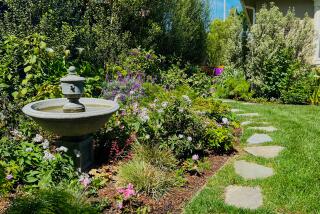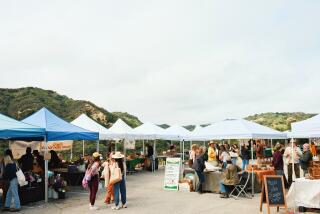Farmers markets: Be aware of the rhythm of the season
April is generally the least abundant month for locally grown fruits, with nothing like the profusion of stone fruits in summer, apples in autumn and citrus in winter. But there’s still plenty of great choices at farmers markets, particularly for shoppers alert to the rhythm of seasons and growing areas.
Strawberries, near peak now from San Diego to Santa Maria, are the dominant spring fruit in their ubiquity and mass appeal. Experienced shoppers look for berries red all the way to the top and richly perfumed. But plants produce sour berries one week while concentrating on vegetative growth and sweet fruit a few weeks later in a frustratingly inscrutable cycle; the only useful strategy is to sniff and sample, although this is not infallible, since vendors typically offer their best fruits as tasters.
A tip for strawberry connoisseurs: After experimenting last year with Mara des Bois, an exquisitely aromatic French variety, this season Harry’s Berries put in 8,000 plants, which should start bearing in quantity shortly; look for them later this month at Santa Monica’s Wednesday market.
Rhubarb, strawberry’s classic partner, is likewise available year-round but peaks in quality and seasonal appeal this month. My favorite grower is Laney Villalobos of Valley Center, who brings, large, tender, deep-red stalks of the Cherry variety, arguable the best in this region, to Santa Monica’s downtown market on Saturdays.
Local production of blueberries, once rare, has surged in recent years. A trickle is available year-round, but prime season for coastal growers, including most farmers market blueberry vendors, is April and May. My favorite is Forbidden Fruit Orchards of Lompoc, at the Brentwood, Mar Vista, Hollywood, Santa Monica and Studio City markets. They’re certified organic, the berries are plump and flavorful, and they really do grow what they sell.
Cherimoyas are in peak season now from northern districts in Ventura and Santa Barbara counties. Prime specimens are a taste treat blending banana, pineapple and papaya, but many vendors offer small or misshapen culls. For superior quality, look for well-filled-out fruits, ideally lightly bronzed by the sun. Top vendor choices include Rincon Del Mar Ranch at Santa Monica on Wednesdays; Rancho Santa Cecilia at Hollywood, Burbank, Torrance and Alhambra; and Westfield Farms at Beverly Hills.
Loquats can show up from March to June, but April and early May, just before stone fruit, is their time to shine. Look for fruits that are deeply colored yellow or orange, depending on the variety. Often the best specimens are slightly bruised. No one sells lots of loquats, but it’s worth looking for them from Louis Diaz (Rancho Mexico Lindo) in Beverly Hills, Darrold McCrary in Hollywood, Elsie Nazarro in Riverside and Mud Creek Ranch in Santa Monica.
Finding the best citrus in spring can be tricky because a given variety, or similar-looking varieties, can be immature, at peak or overmature, depending on the growing area and horticultural factors. Earlier in the season, buying citrus at farmers markets is typically an advantage because commercial packers more often pick too early, when fruit is sour, to get the best prices; farmers market growers are more likely to wait until fruit is reasonably mature. The advantage can continue late in the season, if farmers let fruit hang as it continues to get sweeter and richer in flavor; this is especially so for fruit from Southern California coastal districts, where citrus hangs on the tree in good condition much longer than in the San Joaquin Valley, the state’s largest commercial growing area.
However, later in citrus season the farmers market edge can boomerang when vendors bring fruit that is well past its prime, which commercial channels would usually reject. Customers get lulled into buying the same varieties that were at their peak months before without recognizing that their quality has declined; many farmers continue to bring citrus as long as it remains in plausibly salable condition.
To get the best quality late-season citrus, shoppers must recognize the signs of overmaturity: The rind becomes puffy for the variety. Texture can become overly soft or dry (granulation) with gaping cores and sprouting seeds. Musty off-flavors develop. Most crucially, acidity drops so that the fruit turns unidimensionally sweet, sometimes bland and watery; peak-quality citrus needs counterbalancing acidity to impart welcome punch and tang.
Mandarins, at best the noblest and most flavorful of citrus, are also the most perishable and difficult to select properly. Satsumas, Fairchild and Lee are past by now, period. From Southern California groves, some clementines can still be good, but they’re mostly on their way out; ditto for Fremont and Nova. W Murcott and Tango are in the seventh inning, past peak, but often still good. Pixies and Gold Nuggets generally are still in fine form.
Kinnow, with deep orange flesh, high sugar and intense aromatics, would be one of my top choices now, if only it were more widely available (Rancho de Trinidad sometimes carries it at Hollywood, Beverly Hills and Thousand Oaks). The latest maturing varieties, which may be ripe now in warmer areas but mature a month or more later near the coast, include Fremont, Encore, and Kara.
The classic Washington navel orange can still be good for a month or so, less so pink-fleshed Cara Cara. Late-maturing navels such as Lane Late, Powell and Autumn Gold are not often sold or identified at farmers markets but are worth buying when they turn up.
Valencia, the leading juice orange, also delicious fresh, hangs so late that some growers just finished picking their old crop. The new crop is in full swing from San Joaquin Valley groves; from Southern California, Valencias are getting good from warmer districts like Pauma Valley, but are still tart from cooler areas like Ventura County.
Grapefruit from desert growers such as Everett DaVall and Flying Disc Ranch is at its sweetest and juiciest, with perhaps a month of peak quality left. San Joaquin Valley grapefruit, as from Arnett Farms and Peacock Family Farms, is in full season, although pink varieties are more advanced than whites. Grapefruit from the warmer Southern California districts (Redlands, Pauma Valley) has just sweetened enough to be delicious to most palates; intermediate areas (Valley Center, Fallbrook) are typically a few weeks off; and the coolest areas (Ventura County) are months off, unless you’re looking to strip paint.
More to Read
Eat your way across L.A.
Get our weekly Tasting Notes newsletter for reviews, news and more.
You may occasionally receive promotional content from the Los Angeles Times.






